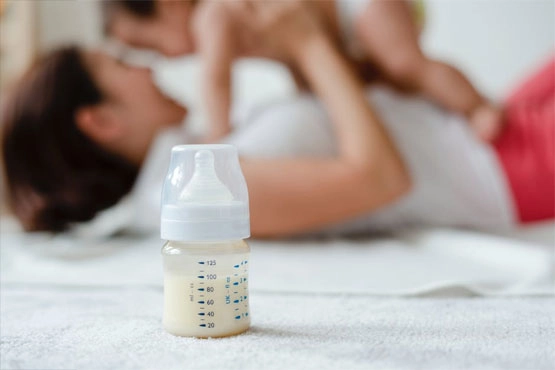FamiBlog
The postpartum period - what is there to know about it?
In gynaecology and obstetrics, the postpartum period is the first 6-8 weeks after the birth of the child. It is a time of change, both in the mother's life and in her body. The changes that occurred during pregnancy are reversed, the body regenerates and slowly returns to the state it was in nine months ago. What should you know about the postpartum period and what complications can be associated with it?

09 February 2024
What is a postpartum period?
This is a period of several weeks after the birth. It can be divided into 3 phases:
- the immediate phase, i.e. the first 24 hours after birth, which harbours the highest risk of complications
- early postpartum period (first week after birth)
- late postpartum period (up to 6-8 weeks after delivery)
In the postpartum period, activities such as carrying more weight than the baby and bathing should be avoided, and sexual intercourse and the use of tampons should also be strictly avoided. Physical activity is not recommended until six weeks after a natural birth, and you should wait about two months after a caesarean section. It is advisable to consult a urogynaecological physiotherapist who will adapt the intensity of the exercises to the woman's current condition. This is important because, among other things, there is a risk of the straight muscles of the abdomen shifting and hernias forming. It is recommended that the woman walks or exercises normally every day during the entire postnatal period.
Changes in the body during the postpartum period
In the postpartum period, a series of changes take place in the woman's body to restore the pre-pregnancy state. The concentration of pregnancy hormones decreases. The prolactin level rises. The uterus shrinks, especially during breastfeeding (due to the effect of oxytocin), and the perineal or caesarean section wounds heal. The vagina stretched during labour returns to its pre-pregnancy state after about three weeks. Please note, however, that the vaginal entrance will usually be freer than before. Depending on whether and how often a woman breastfeeds her child or not, menstruation will occur. This is a consequence of the increased prolactin level during breastfeeding, which affects the reduced oestrogen production and the absence of menstruation. However, this is very individual, as some mothers get their period towards the end of the puerperium, while other women do not get their period until a few weeks after they have finished breastfeeding or started to increase their baby's food intake. The timing of the first ovulation after childbirth is similar. It is important to remember that the absence of menstruation after childbirth does not preclude the presence of ovulation, so breastfeeding cannot be considered a contraceptive method. The loss of blood during childbirth reduces the volume of circulating blood and the haemoglobin concentration, so some women should take iron supplements. Heart rate and blood pressure normalise in the first week after delivery. The iron concentration, on the other hand, should normalise 14 days after delivery.
Postpartum excretions
Due to the regeneration and healing of the uterine lining and the uterus, a woman will experience so-called postpartum discharge after giving birth. Your discharge can continue throughout the entire postpartum period and last up to 6-8 weeks. However, their character changes over time. At first they are blood-coloured, then brown (after a few days of the postpartum period), at the end of the second week they become lighter (yellow) to white-grey, until they finally disappear completely. It is important to ensure good hygiene, as the faeces can be a breeding ground for bacteria. In the event of persistent bleeding or heavy discharge, you should consult your gynaecologist or the emergency room, e.g. to rule out late postpartum haemorrhage.
Complications in the postpartum period
Postpartum mastitis
It affects a third of breastfeeding women and usually occurs around 2-3 weeks after the start of breastfeeding. It can be caused by an incorrect latch-on technique, an injury to the nipple or an overproduction of milk. It is characterised by pain and redness, usually on one breast. If the symptoms do not disappear after emptying the breast and applying compresses, antibiotic therapy is initiated, which usually lasts for 10 days. Occasionally an abscess will develop which will need to be incised and drained by medical staff. It is important to remember that breast cancer has similar symptoms to mastitis; if these do not subside, a histopathological examination should be carried out. It is important that mastitis does not prevent the baby from continuing to breastfeed after the birth.
Venous thromboembolism in the postpartum period
To prevent bleeding during labour, the pregnant woman's body develops a state of hypercoagulability, which is physiological during pregnancy. Therefore, the risk of thrombotic lesions increases considerably during the course of pregnancy. The percentage increases even further in the postnatal period. If a woman also suffers from thrombophilia, the risk of venous thromboembolism is very high. In such situations, doctors administer anticoagulant treatment in accordance with the current recommendations that correspond to the risk factors of the woman in question.
Postpartum endometritis
An endometrial infection occurs most frequently after a caesarean section. It is caused by bacteria from the vagina or the cervical canal. In addition to a caesarean section, risk factors also include premature rupture of the membranes, diabetes mellitus, premature birth or postnatal pregnancy. The symptoms, which include fever and abdominal pain, usually occur on the 3rd to 4th postpartum day, but can also occur throughout the entire postpartum period. Treatment consists of antibiotics. To prevent postpartum endometritis, a dose of an antibiotic is usually administered before the caesarean section.
Postpartum depression
It is considered one of the most common complications in the postpartum period and affects 10-15% of women. Postpartum depression is far more common. It is a mild symptom that occurs in up to 85% of women after giving birth and usually disappears around day 14 of the postpartum period. Specific diagnostic criteria are used to diagnose postpartum depression. The exact cause is not known, but hormonal disturbances experienced by the woman after giving birth may be a contributing factor. Treatment of depression depends on the severity of symptoms and relies on pharmacology and cognitive behavioural therapy, among others. The symptoms associated with postpartum depression should not be underestimated, as without appropriate treatment it can last for a very long time and have far-reaching consequences.
Sie interessieren sich auch für:
Intimate infections during pregnancy
Many expectant mothers struggle with the annoying symptoms of intimate infections during...
Sore throat during pregnancy
A sore throat is a relatively common condition that also affects pregnant women. However, not all...
Eating raw meat during pregnancy
During pregnancy, the expectant mother has many desires. But not all of them can be freely...
Stem cells and cord blood
Bone marrow was the primary source of stem cells (bone marrow transplantation involves...































